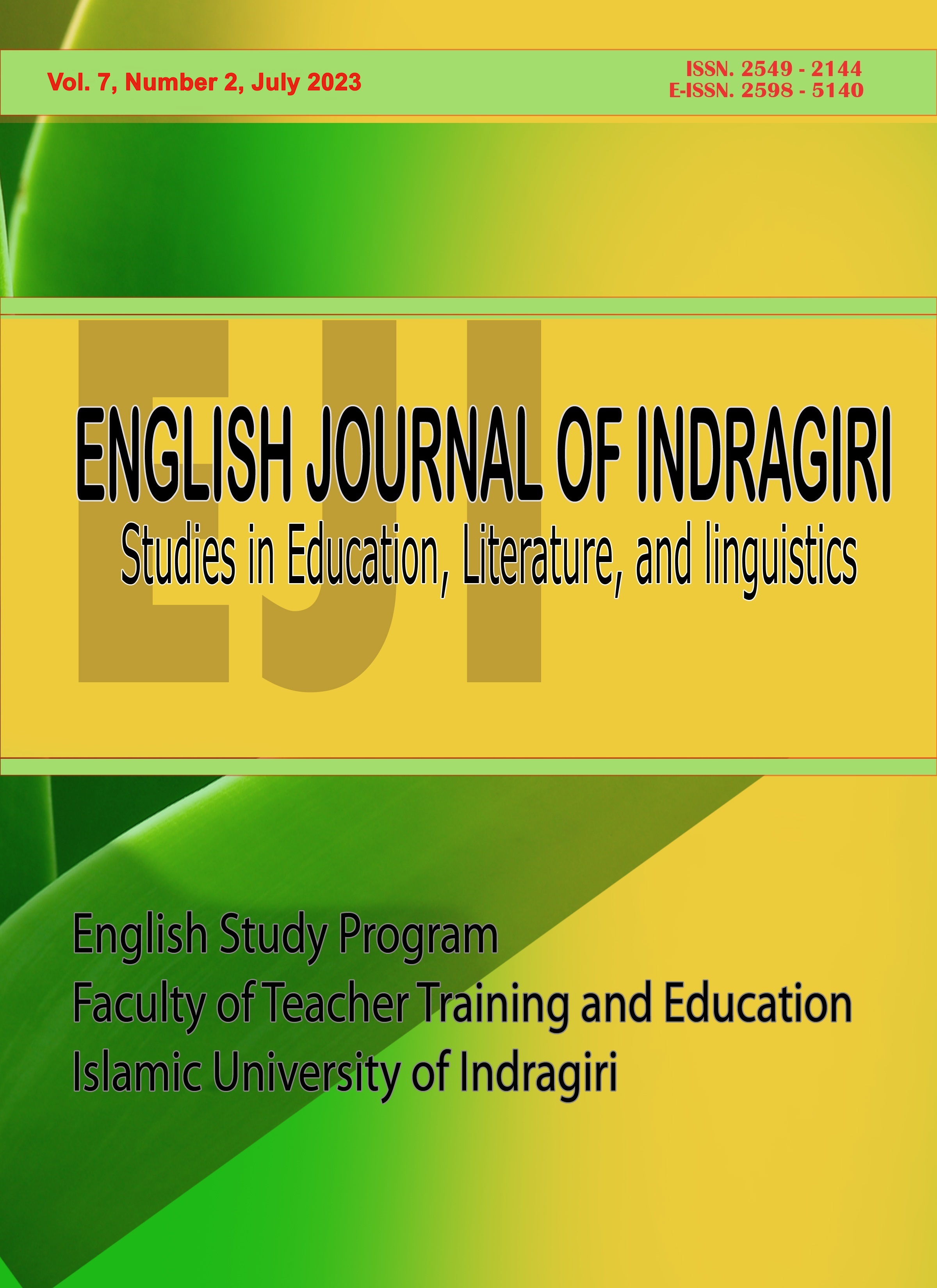TEACHERS' AND STUDENTS' PERCEPTIONS AND THE VARIABLES THAT IMPACT THE PERCEPTIONS OF USING THE ENGLISH CONVERSATION PRACTICE APPLICATION IN SPEAKING CLASS
DOI:
https://doi.org/10.61672/eji.v7i2.2472Keywords:
English conversation practice application, mobile-assisted language learning, speaking classAbstract
The advancement of technology has positive impacts on education. This study aims to identify teachers' and students' perceptions and the variables that impact EFL teachers' and learners' perceptions of using the English Conversation Practice application in speaking class. This study involved thirty-three pupils and three English teachers from SMK Negeri 1 Gianyar, who were chosen using the purposive sampling technique. The data were collected through interviews and observation and analyzed using the interactive data analysis model. The study results show that the students and teachers positively perceive implementing the 'English Conversation Practice' application in speaking class. Besides, the variables that impact EFL teachers' and learners' perceptions of the use of the English Conversation Practice application in speaking class were that the application gave them a new experience in learning to speak, it is simple to use, it does not require a large internet quota, and it allows for the flexibility of learning at any time and in any location. Thus, considering the study's results, it is recommended that EFL teachers use the Conversation Practice application in their speaking class.
References
Alsied, S. M. (2019). The Role of Mobile Phones as Effective Tools for Language Learning by Libyan EFL Learners. JEELS (Journal of English Education and Linguistics Studies), 6(2). https://doi.org/10.30762/jeels.v6i2.1234
Auliya, P. K., Ardiyansah, T. Y., & Muhammad, R. N. (2021). Mobile Assisted Language Learning: Platfoms To Support Students Teacher Improving Reading Skill. Journal of English Teaching, Literature, and Applied Linguistics, 5(1). https://doi.org/10.30587/jetlal.v5i1.2527
Cabrera-Solano, P., Quinonez-Beltran, A., Gonzalez-Torres, P., Ochoa-Cueva, C., & Castillo-Cuesta, L. (2020). Enhancing EFL students’ active learning by using “formative” on mobile devices. International Journal of Emerging Technologies in Learning, 15(13). https://doi.org/10.3991/ijet.v15i13.13975
Curum, B., & Khedo, K. K. (2021). Cognitive load management in mobile learning systems: principles and theories. Journal of Computers in Education, 8(1). https://doi.org/10.1007/s40692-020-00173-6
Darmawati, B., Rahman, M. A., & Halim, A. (2020). The implementation of literature-based instruction in EFL classroom: A case study in an Indonesian junior high school. Asian EFL Journal, 27(2).
Gao, C., & Shen, H. Z. (2021). Mobile-technology-induced learning strategies: Chinese university EFL students learning English in an emerging context. ReCALL, 33(1). https://doi.org/10.1017/S0958344020000142
Hoi, V. N., & Mu, G. M. (2021). Perceived Teacher Support and Students’ Acceptance of Mobile-Assisted Language Learning: Evidence from Vietnamese Higher Education Context. British Journal of Educational Technology, 52(2). https://doi.org/10.1111/bjet.13044
Howlett, G., & Waemusa, Z. (2019). 21 st century learning skills and autonomy: Students’ perceptions of mobile devices in the Thai EFL context. Teaching English with Technology, 19(1).
Hsu, H. T., & Lin, C. C. (2022). Extending the Technology Acceptance Model of College Learners’ Mobile-Assisted Language Learning by Incorporating Psychological Constructs. British Journal of Educational Technology, 53(2). https://doi.org/10.1111/bjet.13165
Irudayasamy, J., Uba, S. Y., & Hankins, C. A. (2021). Exploration and Exploitation of Mobile Apps for English Language Teaching: A Critical Review. English Language Teaching, 14(4). https://doi.org/10.5539/elt.v14n4p43
Juniardi, Y., Herlina, L., Lubis, A. H., Irmawanty, & Pahamzah, J. (2020). Computer-vs. mobile-assisted learning to promote EFL students’ speaking skills: A preliminary classroom-based research. International Journal of Instruction, 13(3). https://doi.org/10.29333/iji.2020.13329a
Kassem, M. A. M. (2018). Improving EFL Students’ Speaking Proficiency and Motivation: A Hybrid Problem-based Learning Approach. Theory and Practice in Language Studies, 8(7). https://doi.org/10.17507/tpls.0807.17
Katemba, C. V. (2019). Students’ vocabulary enhancement at grade 10: A comparative study using CALL & MALL in Indonesia. CALL-EJ, 20(1).
Klimova, B. (2021). Evaluating impact of mobile applications on EFL university learners’ vocabulary learning - A review study. Procedia Computer Science, 184. https://doi.org/10.1016/j.procs.2021.03.108
Klimova, B., & Zamborova, K. (2020). Use of mobile applications in developing reading comprehension in second language acquisition —A review study. In Education Sciences (Vol. 10, Issue 12). https://doi.org/10.3390/educsci10120391
Kusmaryani, W., Musthafa, B., & Purnawarman, P. (2019). The influence of mobile applications on students’ speaking skill and critical thinking in English language learning. Journal of Physics: Conference Series, 1193(1). https://doi.org/10.1088/1742-6596/1193/1/012008
Le, V. H. H., & Nguyen, H. N. (2021). Mobile phones’ video recording tool: A solution to freshmen’s english-speaking anxiety. International Journal of Computer-Assisted Language Learning and Teaching, 11(2). https://doi.org/10.4018/IJCALLT.2021040102
Liu, C., He, J., Ding, C., Fan, X., Hwang, G. J., & Zhang, Y. (2021). Self-oriented learning perfectionism and English learning burnout among EFL learners using mobile applications: The mediating roles of English learning anxiety and grit. Learning and Individual Differences, 88. https://doi.org/10.1016/j.lindif.2021.102011
Lu, H. W., Lee, J. Y., & Lin, M. H. (2019). Effects of Authentic English-Language Videos on EFL Students’ Speaking Anxiety. International Journal of Information and Education Technology, 9(6). https://doi.org/10.18178/ijiet.2019.9.6.1239
Miles, M. B., Huberman, A. M., & Saldaña, J. (2014). Qualitative data analysis (3rd ed.). SAGE Publication.
Milheim, K. L., Fraenza, C., & Palermo-Kielb, K. (2021). Supporting student-initiated mobile device use in online learning. Online Learning Journal, 25(3). https://doi.org/10.24059/olj.v25i3.2438
Narulita Mahendra, F. F. (2020). MOBILE ASSISTED LANGUAGE LEARNING: INCREASING STUDENTS’ READING INTEREST TROUGH E-BOOK. ACITYA Journal of Teaching & Education, 2(1). https://doi.org/10.30650/ajte.v2i1.272
Navidinia, H., Mobaraki, M., & Malekzadeh, F. (2019). Investigating the effect of noticing on EFL students’ speaking accuracy. International Journal of Instruction, 12(1). https://doi.org/10.29333/iji.2019.1216a
Nuraeni, C., Carolina, I., Supriyatna, A., Widiati, W., & Bahri, S. (2020). Mobile-Assisted Language Learning (MALL): Students’ Perception and Problems towards Mobile Learning in English Language. Journal of Physics: Conference Series, 1641(1). https://doi.org/10.1088/1742-6596/1641/1/012027
Octavia, H., Widiati, U., & Irawati, E. (2019). Vocational Students’ Perceptions of Mobile Assisted Language Learning (MALL) Materials. Jurnal Pendidikan: Teori, Penelitian, Dan Pengembangan, 4(10). https://doi.org/10.17977/jptpp.v4i10.12842
Quoquab, F., & Mohammad, J. (2020). Cognitive, affective and conative domains of sustainable consumption: Scale development and validation using confirmatory composite analysis. Sustainability (Switzerland), 12(18). https://doi.org/10.3390/SU12187784
Rajendran, T., & Md Yunus, M. (2021). A Systematic Literature Review on the use of Mobile-assisted Language Learning (MALL) for Enhancing Speaking Skills among ESL and EFL Learners. International Journal of Academic Research in Progressive Education and Development, 10(1). https://doi.org/10.6007/ijarped/v10-i1/8939
Rudyshyn, S. D., Stakhova, I. A., Sharata, N. H., Berezovska, T. V., & Kravchenko, T. P. (2021). The effects of using a case study method for environmental education. International Journal of Learning, Teaching and Educational Research, 20(6). https://doi.org/10.26803/IJLTER.20.6.17
Sen, M. (2021). CALL & MALL: The New Age Language Learning. International Journal of English Learning & Teaching Skills, 3(3). https://doi.org/10.15864/ijelts.3309
Syafiq, A. N., Rahmawati, A., Anwari, A., & Oktaviana, T. (2021). Increasing Speaking Skill through YouTube Video as English Learning Material during Online Learning in Pandemic Covid-19. Elsya : Journal of English Language Studies, 3(1). https://doi.org/10.31849/elsya.v3i1.6206
Downloads
Published
Issue
Section
License
Copyright (c) 2023 Komang Bayu Widhyasmara Putra, Dewa Putu Ramendra, I G A Lokita Purnamika Utami

This work is licensed under a Creative Commons Attribution 4.0 International License.




















